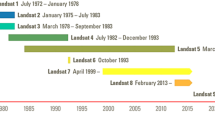Abstract
Remote sensing data collected by the Environment Satellite I are characterized by high temporal resolution, high spectral resolution and mid-high spatial resolution. We designed the Remote Sensing Application System for Water Environments (RSASWE) to create an integrated platform for remote sensing data processing, parameter information extraction and thematic mapping using both remote sensing and GIS technologies. This system provides support for regional water environmental monitoring, and prediction and warning of water pollution. Developed to process and apply data collected by Environment Satellite I, this system has automated procedures including clipping, observation geometry computation, radiometric calibration, 6S atmospheric correction and water quality parameter inversion. RSASWE consists of six subsystems: remote sensing image processing, basic parameter inversion, water environment remote sensing thematic outputs, application outputs, automated water environment outputs and a non-point source pollution monitoring subsystem. At present RSASWE plays an important role in operations at the Satellite Environment Center.
Similar content being viewed by others
References
Hao F, Li C, Zhao Y W, et al. Basin Water Quality Models and Simulation (in Chinese). Beijing: Beijing Normal University Press, 2008. 12–14
Wu C, Yang Z, Wang Q, et al. A reverse method of chlorophyll-a based on dynamic apex (in Chinese). Lake Sci, 2009, 21: 223–227
Doerffer R, Murphy D. Factor analysis and classification of remotely sensed data for monitoring tidal flats. Helgol Meeresunters, 1989, 43: 276–293
Qi F, Wang X J. Remote sensing applications of inland water quality monitoring and evaluation (in Chinese). Environ Sci Prog, 1999, 7: 90–99
Dekker A G, Brando V E, Anstee J M, et al. Imaging Spectrometry of Water. In: van der Meer F D, De Jong SM. Imaging Spectrometry: Basic Principles and Prospective Applications. Dordrecht: Kluwer Academic Publishers, 2001. 307–359
Bukata R P. Satellite Monitoring of Inland and Coastal Water Quality-Retrospection, Introspection, Future Directions. Boca Raton: Taylor & Francis, 2005
Giardinoa C, Brandob V E, Dekkerb A G, et al. Assessment of water quality in Lake Garda (Italy) using Hyperion. Remote Sens Environ, 2007, 109: 183–195
Dall’Olmo G, Gitelson A A, Rundquist D C, et al. Assessing the potential of SeaWiFS and MODIS for estimating chlorophyll concentration in turbid productive waters using red and near-infrared bands. Remote Sens Environ, 2005, 96: 176–187
Van Mol B V, Park Y J, Ruddick K, et al. Mapping of chlorophyll and suspended particulate mater maps from CHRIS imagery of the Oostende core site. Proceedings of the 2nd CHRIS/Proba Workshop, 2004
Van Mol B V, Ruddick K. The compact high resolution imaging spectrometer (CHRIS): The future of hyperspectral satellite sensors. Imagery of Oostende coastal and inland waters. The Airborne Imaging Spectroscopy Workshop, 2004
Dekker A G, Vos R J, Peters S W M. Analytical algorithms for lake water TSM estimation for retrospective analyses of TM and SPOT sensor data. Int J Remote Sens, 2002, 23: 15–35
Giardino C, Candiani G, Zilioli E. Detecting chlorophyll-a in Lake Garda using TOA MERIS radiances. Photogramm Eng Remote Sens, 2005, 71: 1045–1051
Bai Z G. China’s constellation of small satellites for environment and disaster monitoring and forecasting (in Chinese). Aerospace China, 2009, (5): 10–16
Wu Y F. Key technology research of digital water environment platform (in Chinese). Doctoral Dissertation. Beijing: Graduate University of Chinese Academy of Sciences, 2010. 113–115
Fu G, Baith K S, McClain C R. SeaDAS: The SeaWiFS data analysis system. In: Proceedings of the 4th Pacific Ocean Remote Sensing Conference, Qingdao, China, 1998. 73–77
Author information
Authors and Affiliations
Corresponding author
Rights and permissions
About this article
Cite this article
Wu, C., Wang, Q., Zhang, Y. et al. Remote sensing application system for water environments developed for Environment Satellite 1. Sci. China Earth Sci. 53 (Suppl 1), 45–50 (2010). https://doi.org/10.1007/s11430-010-4129-2
Received:
Accepted:
Published:
Issue Date:
DOI: https://doi.org/10.1007/s11430-010-4129-2




